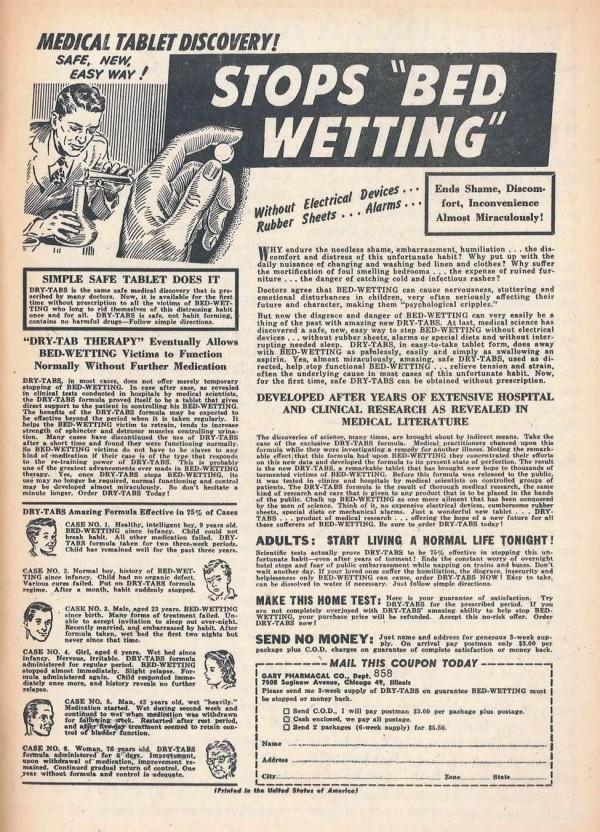Medicine
Raincoat Respirator
Another example of an attractive woman (Gail Andrews) modeling a strange piece of equipment.In this case, the equipment was a "raincoat respirator" invented by John Emerson of Cambridge, Mass. and displayed at a meeting of the American Academy of Pediatrics in October 1960. It was an oversive plastic bag "much like a huge raincoat" attached to a modified vacuum cleaner motor. It helped patients breathe.

Posted By: Alex - Tue Dec 31, 2013 -
Comments (3)
Category: Medicine, 1960s
Dry-Tabs

As you might suspect, these pills eventually met with Federal displeasure.
Posted By: Paul - Mon Dec 23, 2013 -
Comments (4)
Category: Bathrooms, Body, Medicine, Advertising, Body Fluids, 1950s
Ambition Pills for Weak and Nervous Men

Ads for these pills ran in many papers in the late 19th century. What was it in the pills that provided the ambition? If these pills were the same as 'Wendell's Ambition Pills,' which came on the market slightly later, then it was strychnine:
The Journal A.M.A., Apr 6, 1918.
Posted By: Alex - Sun Dec 15, 2013 -
Comments (3)
Category: Health, Medicine, Nineteenth Century
The Odon Device
Jorge Odon was an Argentinian car mechanic who, one day, watched a video on YouTube that showed a trick for removing a cork that's stuck inside a wine bottle. Even though he had no medical training at all, the video inspired him to create a device to help deliver babies who are stuck inside the birth canal. And apparently the device (he's called it the Odon Device) actually works — enough so that an American medical technology firm has agreed to manufacture it. [Yahoo!]I can't seem to remember the last brilliant idea I had while watching YouTube videos.

Posted By: Alex - Wed Nov 27, 2013 -
Comments (9)
Category: Inventions, Medicine
Singing Pills
If your drugs are singing to you, you've probably already overdosed.
Posted By: Paul - Sat Nov 23, 2013 -
Comments (3)
Category: Anthropomorphism, Delusions, Fantasies and Other Tricks of the Imagination, Medicine, PSA’s, 1980s
Magneto-Conservative Garments
Advertised in the Los Angeles Herald and elsewhere, late 19th and early 20th centuries:

More in extended >>
Posted By: Alex - Fri Nov 22, 2013 -
Comments (5)
Category: Fashion, Underwear, Medicine, Nineteenth Century
Mummies, Cannibals, and Vampires
Mummies, Cannibals and Vampires: the History of Corpse Medicine from the Renaissance to the VictoriansThese were the most common drugs derived from the human body. But, as we will see, for certain practitioners and patients, there was almost nothing between the head and the feet which could not be used in some way: hair, brain, heart, skin, liver, urine, menstrual blood, placenta, earwax, saliva and faeces. Medicinal cannibalism was practised to some extent in the Middle Ages. But, with nice irony, it became most popular and pervasive in the era when reports of New World cannibals were circulating amidst the outraged Christians of Rome, Madrid, London and Wittenberg.
Posted By: Alex - Thu Nov 07, 2013 -
Comments (6)
Category: Medicine
Worm Cakes

I wish they provided more information, since I'm not sure whether these cakes actually consisted of ground-up worms or whether they were some kind of anti-worm medication, such as pomegranate extract (which has been known for centuries to be effective against tapeworms).
Posted By: Alex - Fri Sep 20, 2013 -
Comments (9)
Category: Medicine
Left behind in the acupuncture clinic
Acupuncturist Dr. Jeff Tsing says he's "baffled" at how he could have closed up his business for the day and gone home, failing to remember that a patient was still lying on his table, needles in. wfaa.com
Posted By: Alex - Tue Aug 27, 2013 -
Comments (4)
Category: Medicine
Update on the cow urine industry
The "remote nondescript village" of Uttarakshi in India is taking a leap into the modern age. The villagers are helping to finance the construction of "an ultra modern hi tech distillation plant of 8000 litres capacity." What they'll be distilling is cow urine.According to the press release on pharmabiz.com:
If all goes well, the Uttarakshi plant can be expanded to up production to 10,000 litres of the liquid gold daily.
Posted By: Alex - Tue Jul 16, 2013 -
Comments (5)
Category: Medicine, Cows

| Who We Are |
|---|
| Alex Boese Alex is the creator and curator of the Museum of Hoaxes. He's also the author of various weird, non-fiction, science-themed books such as Elephants on Acid and Psychedelic Apes. Paul Di Filippo Paul has been paid to put weird ideas into fictional form for over thirty years, in his career as a noted science fiction writer. He has recently begun blogging on many curious topics with three fellow writers at The Inferior 4+1. Contact Us |





